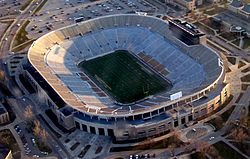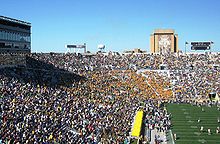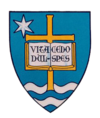- Notre Dame Stadium
-
Notre Dame Stadium The House That Rockne Built Location Notre Dame, IN 46556 Coordinates 41°41′54″N 86°14′2″W / 41.69833°N 86.23389°WCoordinates: 41°41′54″N 86°14′2″W / 41.69833°N 86.23389°W Broke ground 1930 Opened 1930 Owner University of Notre Dame Operator University of Notre Dame Surface Kentucky Blue Grass Construction cost US$750,000 Capacity 80,795 Tenants Notre Dame Fighting Irish (NCAA) (1930-present) Notre Dame Stadium is the home football stadium for the University of Notre Dame Fighting Irish football team. The stadium is located on the campus of the University of Notre Dame in Notre Dame, Indiana, United States, just north of the city of South Bend.
Contents
History
The stadium opened its gates in 1930, replacing the old stadium Cartier Field. Total cost of construction was more than $750,000. The original seating capacity was 54,000. Knute Rockne played a key role in its design, keeping the space between the playing field and the stands to a minimum. The stadium is patterned, on a smaller scale, after Michigan Stadium, the main difference being the tunnel location. In 1929 plans were started by Osborn Engineering of Cleveland, Ohio. They were selected for their experience in designing Yankee Stadium and Fenway Park. The original stadium held 59,075 people, measured a half-mile in circumference, stood 45 feet high, and featured a glass-enclosed press box rising 60 feet above ground level. The building was built by the Sollitt Construction Company of South Bend. They began earth preparation in the fall of 1929, but due to an unusually cold fall and winter, above ground construction did not begin until April 2, 1930. This building was effectively built in six months. Over two million bricks were used in the construction of the walls and the concrete was placed in a monolithic continuous placement by section. There were over 300 workers on the site at most times and they worked five 10 hour days and one six hour day on saturdays. The average worker was paid one dollar a day plus lunch with the more skilled workers earning up to five dollars a day. [1]
The construction of the stadium project was brought to a head by the actions of Knute Rockne. 1928 had not been a stellar year for the football team, however the 1928 net profits from football for that season approached $500,000. Rockne was frustrated with the slow and cautious Holy Cross Priests and their decision making process about spending money on the new stadium. Rockne could not believe that with such a large amount of money in the bank why were they waiting. Because of this and a number of other issues Rockne submitted his resignation to Father O’Donnell, the President of the University. O’Donnell knew of Rockne’s history of submitting his resignations and he also knew that nothing would ever completely satisfy Rockne. O’Donnell was willing to find a compromise but was also unwilling to put the University in debt to finance the stadium. O’Donnell knew that the excess receipts from 1928 season and the projected receipts from playing all the away games in 1929 on neutral fields would bring adequate cash into the University to finance the construction of the Stadium. O’Donnell also devised the scheme to finance 240 six person “reserved box seats”. This precursor of the Personal Seat License would allow the buyer to purchase tickets at face value and guarantee the same prime location for 10 years for an investment of $3000 between the 45 yard lines, $2500 between the 45 and 35 yard line and $2000 between the 35 and the 25 yard line. The University raised over $150,000 on this idea alone. [2]
The Irish played their first game in the new stadium on October 4, 1930, beating Southern Methodist University 20–14. The official dedication was on October 11 against Navy. Over the years, its capacity was gradually increased to 59,075, mainly by changing the average seat size from 18 inches in width to 17 inches. In 1997, 21,000 new seats were added to the stadium, bringing the seating capacity to the present 80,795. The playing surface has always been natural grass.
Lighting
Prior to the 1997 expansion, Notre Dame Stadium lacked permanent field lights. On September 18, 1982, portable lighting by Musco Lighting was used for the first night game in the stadium's history. Permanent lights were installed as part of the expansion. The lights were paid for by NBC, which has held the exclusive television rights to all home games since 1991. The permanent lights were added primarily to ensure sufficient lighting for mid-afternoon games in November; the university's agreement with NBC stipulates that there be no home night games.[3] However, the stadium hosted its first night game in 21 years on October 22, 2011 when the Irish hosted USC. [4]
"Touchdown Jesus"
The stadium is known for its view of "Touchdown Jesus", a nickname given to the large mural entitled The Word of Life by Millard Sheets of the resurrected Jesus.[5] Installed in 1964 on the Hesburgh Library, the mosaicked wall looms over the stadium mirroring the raised arms of a referee signifying a touchdown. Installed during the spring of 1964, the stadium expansion had the side effect of partially obscuring the view of the mural from the field. The Word of Life Mural was a gift of Mr. and Mrs. Howard V. Phalin of Winnetka, Illinois.
Attendance
Prior to 1966, attendance figures were based on the total in the house. The largest crowd to attend a home game prior to expansion was 61,296 on October 6, 1962, against Purdue. Since 1966, attendance figures have been based on paid admissions with a fixed number of tickets available, accounting for the familiar 59,075 figure through the 1996 season. Until Ara Parseghian arrived as coach at Notre Dame in 1964, sellouts were not the norm. Since then, tickets to a Notre Dame football game have been notoriously hard to come by. As of the conclusion of the 2010 season, there have been 219 consecutive sellouts at Notre Dame Stadium, and 257 sellouts in the past 258 games dating back to 1966. The lone exception was a 1973 game against Air Force which had been moved midseason by ABC to Thanksgiving Day and was played with the students absent. The announced attendance was 57,235. Attendance at all five home games in 1965 exceeded 59,000 as well.
The official capacity was listed at 80,225 when the stadium was first expanded. A subsequent computer revision put it at 80,012. Sideline bleachers, which had been removed during expansion, were put back in after a few years, bringing the figure to its present 80,795.
References
- ^ Notre Dame archives
- ^ Being Catholic, Being American The Notre Dame Story, 1842-1934, Robert E Burns, University of Notre Dame Press, Notre Dame Indiana,1999
- ^ http://www.azcentral.com/sports/colleges/articles/2008/06/19/20080619nbcnd.html
- ^ http://www.und.com/sports/m-footbl/sched/nd-m-footbl-sched.html
- ^ University of Notre Dame Hesburgh Libraries, Hesburgh (Main) Library Word of Life Mural
External links
Notre Dame Fighting Irish football Established 1887 · based in Notre Dame, IndianaThe University University of Notre Dame · Location: Notre Dame, Indiana · President: Rev. John I. Jenkins, C.S.C. · Athletic Director: Jack SwarbrickHead coaches Affiliation Stadiums Cartier Field · Notre Dame StadiumRivalries Culture Lore Four Horsemen · "Win One for the Gipper" · Notre Dame Box · Jeweled Shillelagh · "The Game of the Century" (1946) · "The Game of the Century" (1966) · "The Chicken Soup Game" · Catholics vs. Convicts · 1991 Orange Bowl · "The Game of the Century" (1993) · Holy War · Shamrock Classic · Ireland Trophy · The "Bush Push" · 2007 Navy vs. Notre Dame football game · Play Like A Champion TodayHeisman Trophy winners National championships (11) BCS berths (3) Seasons (123) 1880s 1890s 1900s 1910s 1920s 1930s 1940s 1950s 1960s 1970s 1980s 1990s 2000s 2010s College football venues in Indiana Division I
FBSBig Ten Memorial Stadium (Indiana) • Ross–Ade Stadium (Purdue)
MAC Independent Notre Dame Stadium (Notre Dame)
Division I
FCSMissouri Valley Pioneer Division II GLFC Alumni Stadium (Saint Joseph's)
GLIAC Key Stadium (Indianapolis)
Division III Heartland Carl W. Burt Memorial Stadium (Manchester) • Cook Stadium (Rose–Hulman) • Faught Stadium (Franklin) • L. S. Ayres Field (Hanover) • Macholtz Stadium (Anderson)
MIAA Shive Field (Trine)
North Coast SCAC Blackstock Stadium (DePauw)
NAIA Mid-States Bishop John M. D'Arcy Stadium (Saint Francis) • George C. Grosskopf Stadium (Marian) • Jim Wheeler Stadium (Taylor)
Categories:- American football venues in Indiana
- Notre Dame Fighting Irish football venues
- Sports venues in South Bend, Indiana
- University of Notre Dame buildings and structures
Wikimedia Foundation. 2010.




